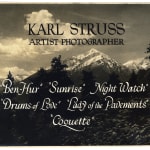Karl Struss
Pair of Unique Advertising photographs, promoting Struss' profession as both Cinematographer and Artist Photographer, c. 1930
Silver prints (2)
Each 9 1/2 x 7 1/2 inches
One with a Wolfer Printing Co. stamp and date, and the other notated "Film Spectator," in pencil verso.
One with a Wolfer Printing Co. stamp and date, and the other notated "Film Spectator," in pencil verso.
Karl Struss was an American photographer and cinematographer who worked during the Golden Age of Hollywood. With over 120 films in his oeuvre, he is most known for his work...
Karl Struss was an American photographer and cinematographer who worked during the Golden Age of Hollywood. With over 120 films in his oeuvre, he is most known for his work on Old Hollywood films such as The Great Dictator and Limelight, both starring Charlie Chaplin, Ben-Hur, and The Fly. A master of camera techniques before digital effects, Struss was a special effects innovator without using dissolves, being the mastermind behind the scene in Ben-Hur in which two women are cured of leprosy in the split second duration of a lightning strike. Another example is the Dr. Jekyll’s transformation into Mr. Hyde which was accomplished through the simple tricks of makeup and lighting. In 1931, Struss was hired by Paramount where he worked as a cinematographer for some of the leading titles of the time. He left the studio in 1945 and turned his interests towards the experimental, particularly 3D, and pursued some of the earliest 3D projects while in Italy. He has been nominated four separate times by the Academy Awards for Best Cinematography and won in 1929 for Sunrise: A Song of Two Humans.
Karl Struss was born November 30, 1886 in New York City. He studied photography at Columbia University under Clarence H. White and invented his own soft-focus lens in 1909. Stuss was a gifted photographer and was exhibited at numerous exhibitions throughout the 1910s. He was personally noticed by Alfred Stieglitz who invited Struss to join the Photo-Secession movement. His images were also featured in fashion magazines such as Vogue, Harper’s Bazaar, and Vanity Fair. After the war in 1919, Struss fatefully moved to California in 1919 for fairer weather where he began working for the director, Cecil B. DeMille. While he continued his photo practice, his cinematography career was soon commensurate to his success in photography. He was a member of the American Society of Cinematographers and the Academy of Motion Picture Arts. He died on December 15, 1981 in Santa Monica, California. Much of his work remains in the collection of the Amon Carter Museum of American Art.
Karl Struss was born November 30, 1886 in New York City. He studied photography at Columbia University under Clarence H. White and invented his own soft-focus lens in 1909. Stuss was a gifted photographer and was exhibited at numerous exhibitions throughout the 1910s. He was personally noticed by Alfred Stieglitz who invited Struss to join the Photo-Secession movement. His images were also featured in fashion magazines such as Vogue, Harper’s Bazaar, and Vanity Fair. After the war in 1919, Struss fatefully moved to California in 1919 for fairer weather where he began working for the director, Cecil B. DeMille. While he continued his photo practice, his cinematography career was soon commensurate to his success in photography. He was a member of the American Society of Cinematographers and the Academy of Motion Picture Arts. He died on December 15, 1981 in Santa Monica, California. Much of his work remains in the collection of the Amon Carter Museum of American Art.



